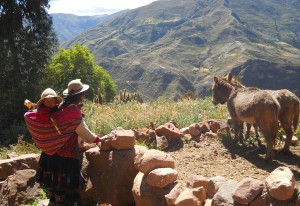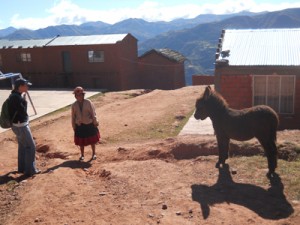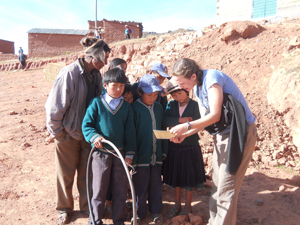Back to Basics

Marquirivi, Bolivia
photo by Lizzie Greene/EWB-UA
“Simple is harder than complicated,” reflects environmental engineering student Andrea F. Corral. Her cohort Vicky Karanikola agrees enthusiastically, “Yeah! Everything is so technologically advanced that you forget the simple. Our designs have to be simplified, they have to be simple to work.”
These University of Arizona doctoral environmental engineering students are discussing the challenges of going back to basics, to help a village in the mountainous Andean climes of Marquirivi, Bolivia gain a luxury the first world takes for granted everyday: sanitary conditions, hot showers and bathrooms.
In a community of 300 people, a population that doubles during agricultural planting and later crop harvesting, there are only three latrines, Karanikola explains. “One in the school, one in the nurse’s station and one outside, and pretty much they don’t work, so nobody uses them. And they have one shower in the nurse’s office, but nobody uses it because it is locked.”
Karanikola, from Greece, and Corral, from Ecuador, are volunteer members of Engineers Without Borders-University of Arizona (EWB-UA). Karanikola is the co-manager, with Jimmy Hackett, of the group’s Marquirivi sanitation project which aims to establish showers with hot water and working latrines. The structures will allow the villagers to bathe comfortably and segregate their waste to end water, crop and field contamination, along with reducing water-borne illnesses.
“Right now, I’m assuming they take showers with a bucket,” Karanikola says, “and heat up the water and use a sponge. But during the winter, the freezing temperatures go to zero, and they are up 14,000 feet, higher than Mount Lemmon.”
To provide the village with hot water, EWB-UA will set up solar thermosyphons, which uses rudimentary science to operate.
“It is very simple how it works,” explains Karanikola. “It has a solar panel and tank and it basically works by the difference in water density created by the different temperatures of the water. You heat up the water in the solar panel, so it becomes lighter and moves up in the tank, and the colder water goes back and gets warm, so it’s very simple. No pumps, and you install it on the roof. I know about it because in Greece it is very common, we use it a lot for heating up the water.”
While the technology for the showers and latrines must be uncomplicated to be established in such a remote area, and subsequently operated and maintained by the villagers, the design and construction processes are challenged by the location’s geological features.

Marquirivi, Bolivia
photo by Lizzie Greene/EWB-UA
“It’s like a 35 percent slope. It makes our design very hard. We start designing something and in the process, we read stuff, we try to figure out things and we realize, ‘this design is not feasible,’ so it is a very long process. So we realize we need to go for a second assessment trip where we completely focus on figuring out the terrain, do very accurate percolation tests, surveying the community,” Karanikola details. “We have two to three different alternative designs, and see which one they prefer. Which one would be better for them to operate and maintain, what would they prefer and do they have enough money to maintain and operate them for the different options we are giving them? So, there’s a lot of work to be done in December.”
The village was first “adopted” by EWB-UA in September 2011, according to EngineersInAction.org/projects/current-projects/marquirivi/. The local student organization had to apply for the project through the national Engineers Without Borders chapter in a rigorous selection process. The group’s first assessment trip was in May 2012. It is now in the design and fund-raising phase for the December 2013 trip.
“It’s hard work!” Corral laughs, shaking her head. “People, when they think about Engineers Without Borders, they don’t really think about fund-raising, so it’s really hard to get people involved in that part of the organization, which is one of the basic cornerstones of the project because without money, we wouldn’t be able to go and do assessment trips and do the implementation.”
While the group has applied for and received several grants to cover travel and project expenses, there are always fiscal needs as EWB-UA has a five year commitment to the village’s sanitation project.
“There’s a process that we will build and monitor and the same time. Our project has many phases, so we don’t want to – we can’t actually – build everything all together,” Karanikola elucidates.
Dr. Wendell Ela, EWB-UA’s faculty advisor/professional mentor since 2004 and UA Chemical and Environmental Engineering Professor since 1998, reiterates the difficulties via email from Zimbabwe. “The current project to try and improve sanitation conditions for the community has a somewhat open-ended time frame, as the technologies to be implemented and number of sites to be addressed are still being designed and determined. It will minimally be a project going into 2016.
“Since the community is on a steep mountain slope at elevations ranging from about 12,500 to over 14,000 feet, the terrain is an obvious challenge. In addition, the community is very dispersed with the residences distributed over the entire area and no real opportunities for significant centralization of sanitation facilities. However, on the positive side, the community has a reasonably reliable and seemingly sufficient potable water supply, so one major hurdle is already surmounted.”
Both of the women speak with a passion for the work, and a deep respect for the community their team is volunteering their time and minds to serve. The depth of the project isn’t just building a couple of showers and toilets. It is following building codes established by the United States, the United Nations, the Environmental Protection Agency, the World Bank. It is presenting the designs to EWB-USA, with exhaustive, precise reports covering the smallest technical details.

Marquirivi, Bolivia
photo by Lizzie Greene/EWB-UA
They also both understand this effort requires people with diverse skills and make it very clear it doesn’t take an engineer to be a part of EWB-UA.
“When we travel, we will need to have people that know about different things, we will need a nurse and someone in the social studies to reach out to the community and do a better survey of the needs of the community – how the community sees our presence there. Do they like it? Are they comfortable with us there? Do they agree with the project? Do they find it fine or do they disagree?” Corral says.
When it comes to community, they both exude appreciation for Casa Vicente, the locale of EWB-UA’s fundraising event on Nov. 24, from 6 p.m.-9 p.m.
As regulars at the downtown Spanish restaurant, 375 S. Stone Ave., the ladies discussed the project with owners Vicente Sanchez and Marita Gomez. “We were talking about it and he thought it would be a good idea to have an event there. So, we are very thankful to him and Marita. They’re great, they gave us great ideas to advertise the event and how to do it, they have done this before so their experience has been really helpful,” smiles Corral. “They are a very giving couple.”
The EWB-UA fundraising event, Noche Boliviano, is Sunday, Nov. 24 and features tapas, flamenco dancing, live music and details on the project. Tickets are $75. More information is at EWB-UA.org or email ewb.arizona@gmail .com.
Category: Community, DOWNTOWN / UNIVERSITY / 4TH AVE, Events




